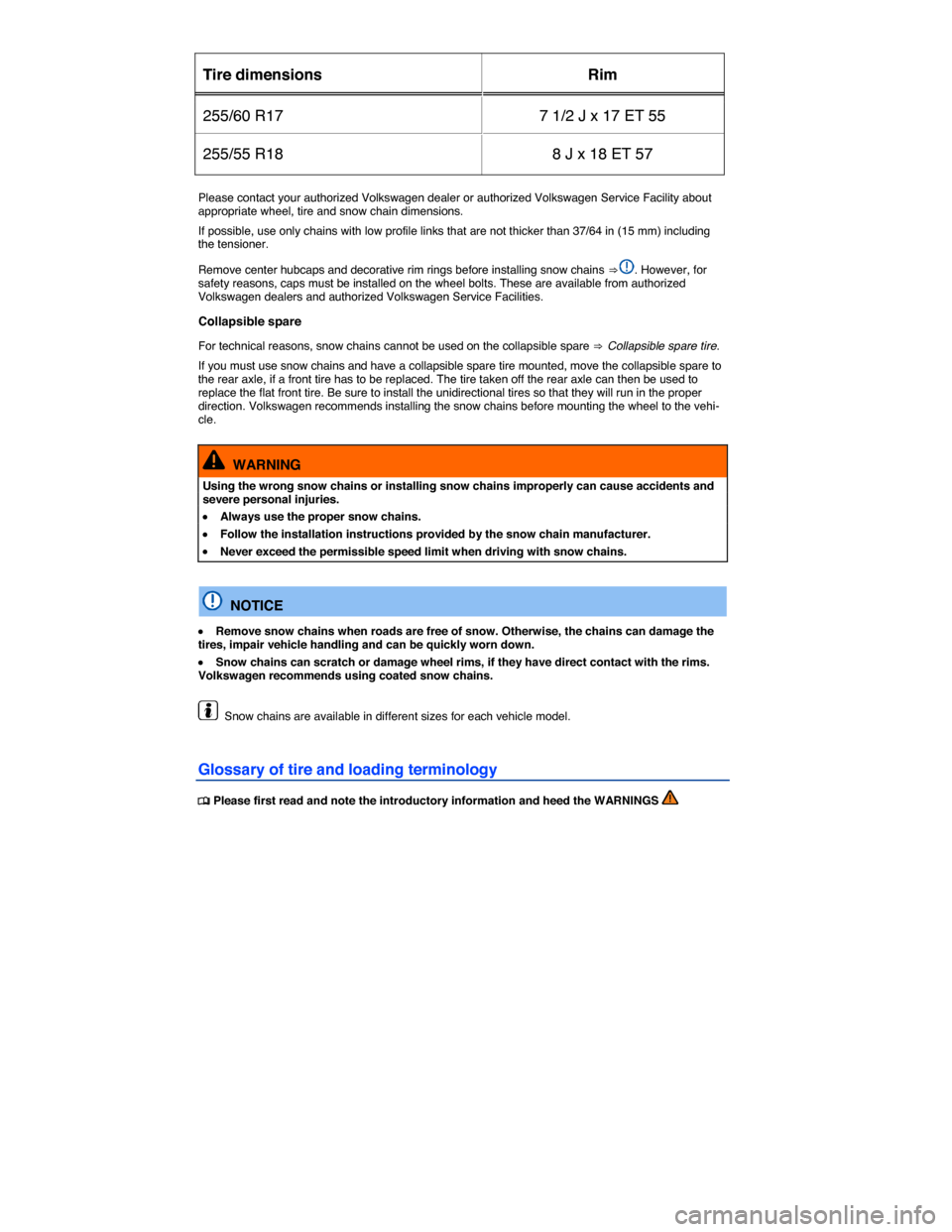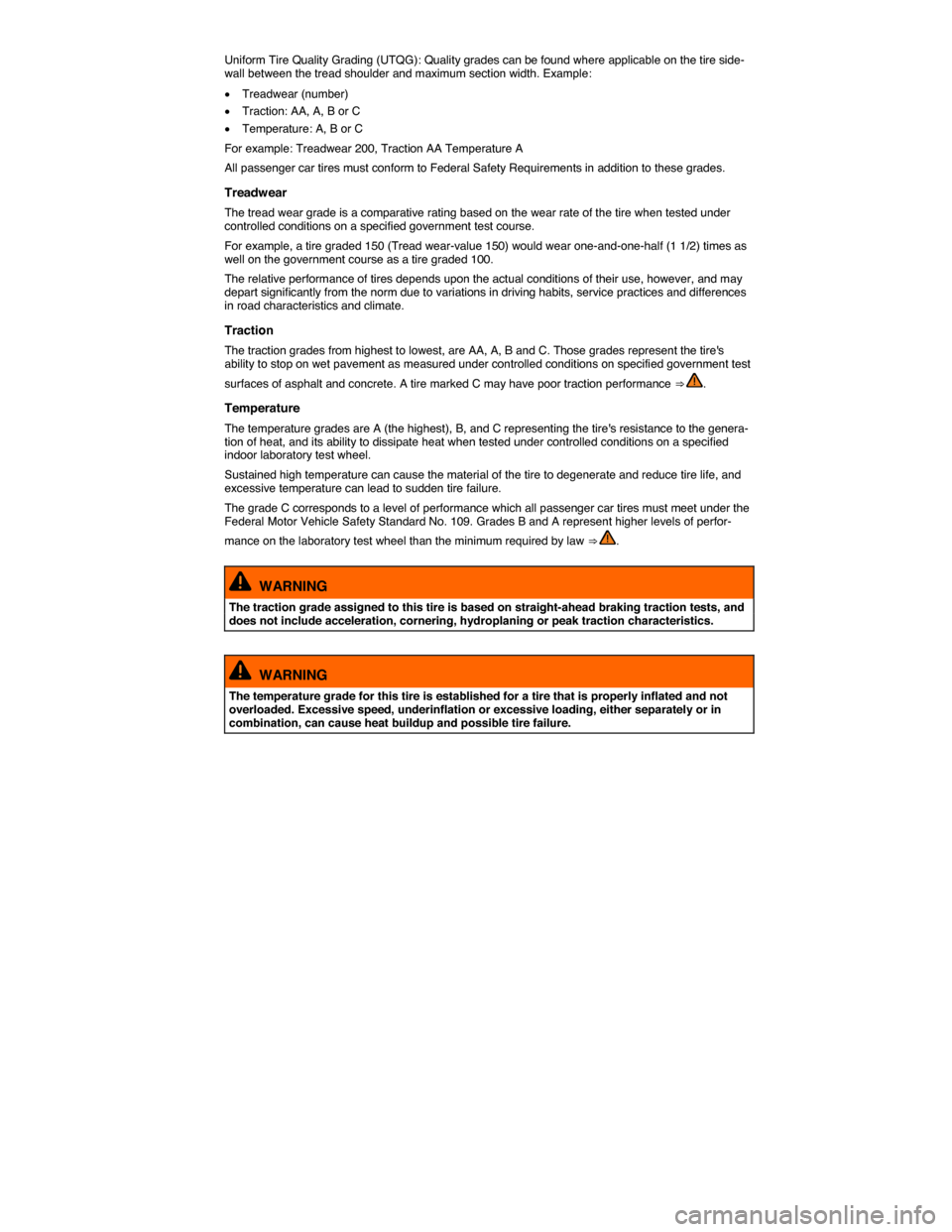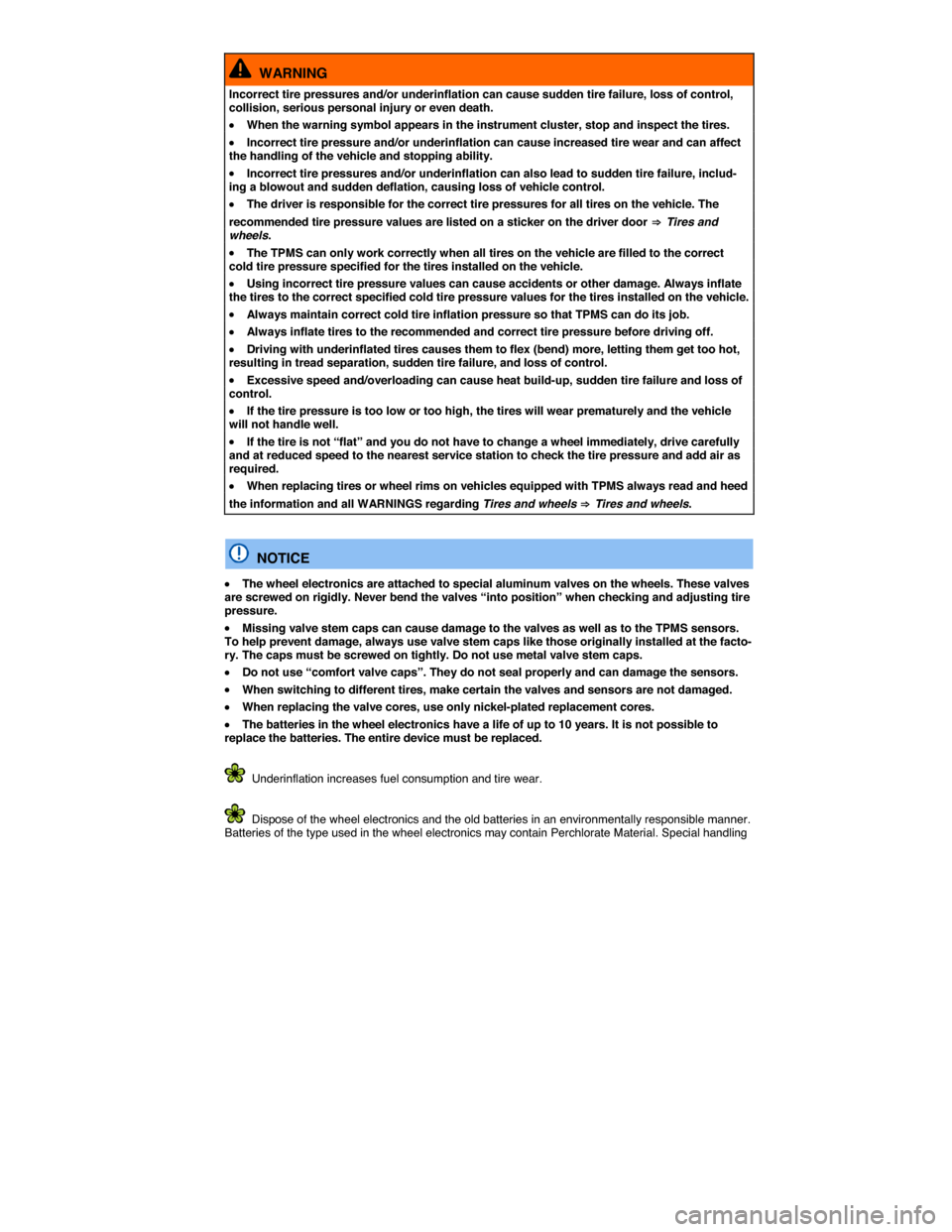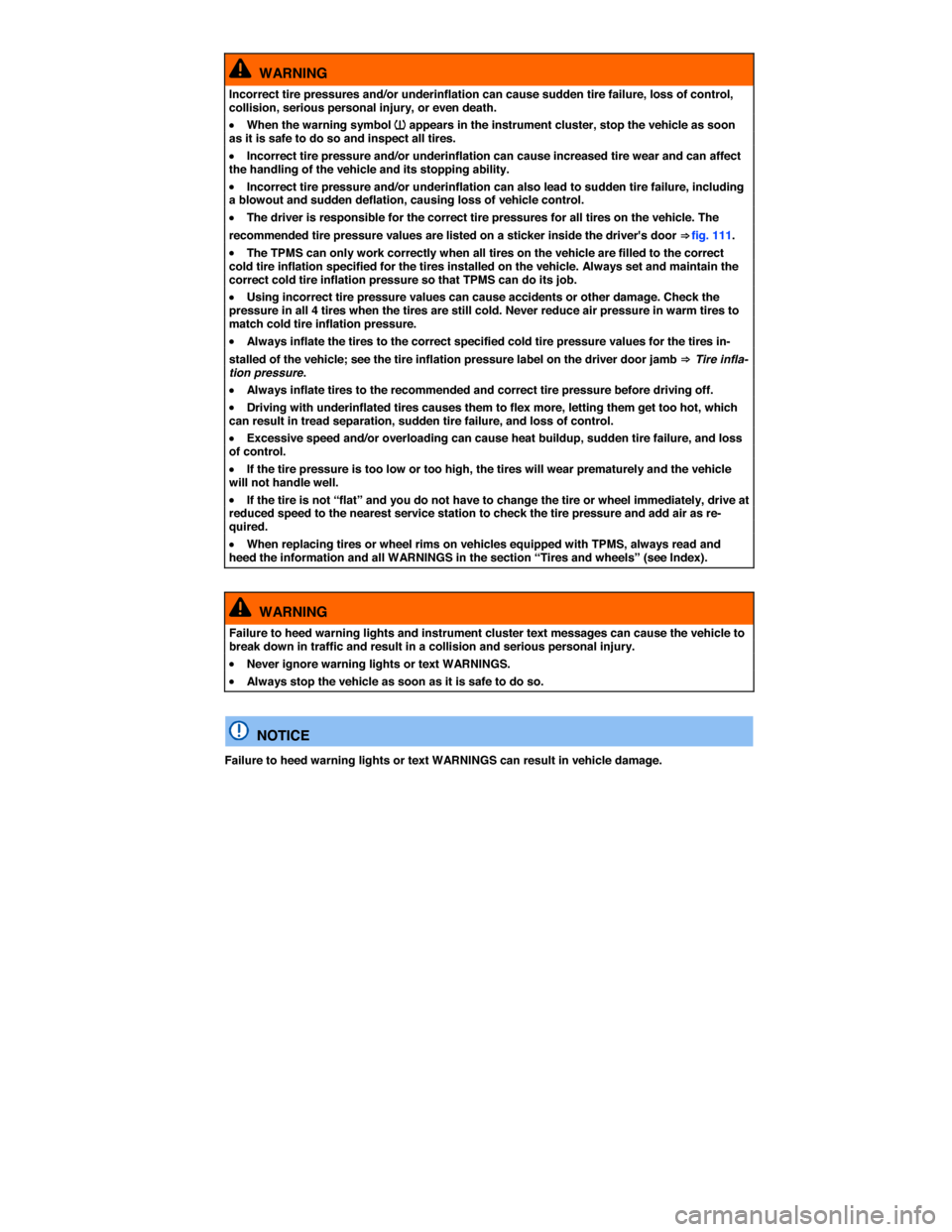2015 VOLKSWAGEN TOUAREG warning
[x] Cancel search: warningPage 194 of 684

All-wheel drive (4MOTION)
Vehicles with all-wheel drive and standard road wheels have good forward motion and traction even under wintery road conditions. However, Volkswagen recommends installing snow tires or all season tires on all 4 wheels to improve handling as well as braking performance.
If you use snow chains, please read and heed information and directions ⇒ Snow chains.
WARNING
Driving faster than the maximum speed for which the winter tires on your vehicle were de-signed can cause sudden tire failure including a blowout and sudden deflation, loss of con-trol, crashes and serious personal injuries.
�x Winter tires have a maximum speed rating that may be lower than your vehicle's maximum speed.
�x Never drive faster than the maximum speed for which the winter tires installed on your vehicle are rated because tires that are driven faster than their rated speed can fail suddenly.
�x Never exceed the maximum load rating for the winter tires installed on your vehicle.
Install summer tires promptly in the spring. Summer tires offer better handling characteristics for temperatures above +45 °F (+7 °C). They are quieter, do not wear as quickly, and reduce fuel con-sumption.
If factory-installed wheels and/or tires are replaced when installing winter tires, make sure that the wheels are equipped with sensors that are compatible with the factory-installed Tire Pressure
Monitoring System (TPMS) and that the tires are also compatible with the system ⇒ Tire Pressure Monitoring System (TPMS). If new tires are not identical to those that were removed and require different cold tire inflation pressure, the tire inflation pressure values must be reprogrammed for the
TPMS. Please see your authorized Volkswagen dealer or authorized Volkswagen Service Facility ⇒ Tire Pressure Monitoring System (TPMS).
If necessary, ask your authorized Volkswagen dealer or authorized Volkswagen Service Facility about permissible winter tire dimensions.
Snow chains
�
Page 195 of 684

Tire dimensions Rim
255/60 R17 7 1/2 J x 17 ET 55
255/55 R18 8 J x 18 ET 57
Please contact your authorized Volkswagen dealer or authorized Volkswagen Service Facility about appropriate wheel, tire and snow chain dimensions.
If possible, use only chains with low profile links that are not thicker than 37/64 in (15 mm) including the tensioner.
Remove center hubcaps and decorative rim rings before installing snow chains ⇒ . However, for safety reasons, caps must be installed on the wheel bolts. These are available from authorized Volkswagen dealers and authorized Volkswagen Service Facilities.
Collapsible spare
For technical reasons, snow chains cannot be used on the collapsible spare ⇒ Collapsible spare tire.
If you must use snow chains and have a collapsible spare tire mounted, move the collapsible spare to the rear axle, if a front tire has to be replaced. The tire taken off the rear axle can then be used to replace the flat front tire. Be sure to install the unidirectional tires so that they will run in the proper direction. Volkswagen recommends installing the snow chains before mounting the wheel to the vehi-cle.
WARNING
Using the wrong snow chains or installing snow chains improperly can cause accidents and severe personal injuries.
�x Always use the proper snow chains.
�x Follow the installation instructions provided by the snow chain manufacturer.
�x Never exceed the permissible speed limit when driving with snow chains.
NOTICE
�x Remove snow chains when roads are free of snow. Otherwise, the chains can damage the tires, impair vehicle handling and can be quickly worn down.
�x Snow chains can scratch or damage wheel rims, if they have direct contact with the rims. Volkswagen recommends using coated snow chains.
Snow chains are available in different sizes for each vehicle model.
Glossary of tire and loading terminology
�
Page 198 of 684

Radial ply tires
A pneumatic tire in which the ply cords that extend to the beads are laid at substantially 90 degrees to the centerline of the tread.
Recommended inflation pressure
The tire pressure recommended by the vehicle manufacturer for a tire of a specified size that has not been driven for more than a couple of miles (kilometers) at low speeds in the 3 hour period before the tire pressure is measured or adjusted.
Reinforced tire
A tire designed to operate at higher loads and at higher inflation pressures than the corresponding standard tire.
Rim
The outer edge of a wheel upon which the tire beads are seated.
Rim diameter
The nominal diameter of the wheel's tire bead seating surface. If you change your wheel size, to wheels of a different diameter, you will have to purchase new tires to match the new wheels.
Rim size
Designation means rim diameter and width.
Rim type designation
The industry or manufacturer's designation for a rim by style or code.
Rim width
The nominal distance between wheel rim flanges.
Section width
The linear distance between the exteriors of the sidewalls of an inflated tire, excluding elevations due to labeling decoration, or protective bands.
Sidewall
The portion of a tire between the bead and the tread.
Sidewall separation
The parting of the rubber compound from the cord material in the sidewall.
Speed rating (letter code)
A standardized letter code indicating the maximum speed at which a tire is designed to be driven for extended periods of time. The ratings range from 93 mph or 150 km/h (“P”) to 186 mph or (300 km/h) “Y”.
The speed rating letter code, where applicable, is molded on the tire sidewall ⇒ Tire labeling. You may not find this information on all tires because it is not required by law.
Tire Pressure Monitoring System (TPMS)
A system that detects when at least one of a vehicle's tires is underinflated and illuminates a low tire-pressure warning light.
Tread
The portion of a tire that normally touches the road.
Page 202 of 684

Uniform Tire Quality Grading (UTQG): Quality grades can be found where applicable on the tire side-wall between the tread shoulder and maximum section width. Example:
�x Treadwear (number)
�x Traction: AA, A, B or C
�x Temperature: A, B or C
For example: Treadwear 200, Traction AA Temperature A
All passenger car tires must conform to Federal Safety Requirements in addition to these grades.
Treadwear
The tread wear grade is a comparative rating based on the wear rate of the tire when tested under controlled conditions on a specified government test course.
For example, a tire graded 150 (Tread wear-value 150) would wear one-and-one-half (1 1/2) times as well on the government course as a tire graded 100.
The relative performance of tires depends upon the actual conditions of their use, however, and may depart significantly from the norm due to variations in driving habits, service practices and differences in road characteristics and climate.
Traction
The traction grades from highest to lowest, are AA, A, B and C. Those grades represent the tire's ability to stop on wet pavement as measured under controlled conditions on specified government test
surfaces of asphalt and concrete. A tire marked C may have poor traction performance ⇒ .
Temperature
The temperature grades are A (the highest), B, and C representing the tire's resistance to the genera-tion of heat, and its ability to dissipate heat when tested under controlled conditions on a specified indoor laboratory test wheel.
Sustained high temperature can cause the material of the tire to degenerate and reduce tire life, and excessive temperature can lead to sudden tire failure.
The grade C corresponds to a level of performance which all passenger car tires must meet under the Federal Motor Vehicle Safety Standard No. 109. Grades B and A represent higher levels of perfor-
mance on the laboratory test wheel than the minimum required by law ⇒ .
WARNING
The traction grade assigned to this tire is based on straight-ahead braking traction tests, and does not include acceleration, cornering, hydroplaning or peak traction characteristics.
WARNING
The temperature grade for this tire is established for a tire that is properly inflated and not overloaded. Excessive speed, underinflation or excessive loading, either separately or in combination, can cause heat buildup and possible tire failure.
Page 204 of 684

WARNING
Incorrect tire pressures and/or underinflation can cause sudden tire failure, loss of control, collision, serious personal injury or even death.
�x When the warning symbol appears in the instrument cluster, stop and inspect the tires.
�x Incorrect tire pressure and/or underinflation can cause increased tire wear and can affect the handling of the vehicle and stopping ability.
�x Incorrect tire pressures and/or underinflation can also lead to sudden tire failure, includ-ing a blowout and sudden deflation, causing loss of vehicle control.
�x The driver is responsible for the correct tire pressures for all tires on the vehicle. The
recommended tire pressure values are listed on a sticker on the driver door ⇒ Tires and wheels.
�x The TPMS can only work correctly when all tires on the vehicle are filled to the correct cold tire pressure specified for the tires installed on the vehicle.
�x Using incorrect tire pressure values can cause accidents or other damage. Always inflate the tires to the correct specified cold tire pressure values for the tires installed on the vehicle.
�x Always maintain correct cold tire inflation pressure so that TPMS can do its job.
�x Always inflate tires to the recommended and correct tire pressure before driving off.
�x Driving with underinflated tires causes them to flex (bend) more, letting them get too hot, resulting in tread separation, sudden tire failure, and loss of control.
�x Excessive speed and/overloading can cause heat build-up, sudden tire failure and loss of control.
�x If the tire pressure is too low or too high, the tires will wear prematurely and the vehicle will not handle well.
�x If the tire is not “flat” and you do not have to change a wheel immediately, drive carefully and at reduced speed to the nearest service station to check the tire pressure and add air as required.
�x When replacing tires or wheel rims on vehicles equipped with TPMS always read and heed
the information and all WARNINGS regarding Tires and wheels ⇒ Tires and wheels.
NOTICE
�x The wheel electronics are attached to special aluminum valves on the wheels. These valves are screwed on rigidly. Never bend the valves “into position” when checking and adjusting tire pressure.
�x Missing valve stem caps can cause damage to the valves as well as to the TPMS sensors. To help prevent damage, always use valve stem caps like those originally installed at the facto-ry. The caps must be screwed on tightly. Do not use metal valve stem caps.
�x Do not use “comfort valve caps”. They do not seal properly and can damage the sensors.
�x When switching to different tires, make certain the valves and sensors are not damaged.
�x When replacing the valve cores, use only nickel-plated replacement cores.
�x The batteries in the wheel electronics have a life of up to 10 years. It is not possible to replace the batteries. The entire device must be replaced.
Underinflation increases fuel consumption and tire wear.
Dispose of the wheel electronics and the old batteries in an environmentally responsible manner. Batteries of the type used in the wheel electronics may contain Perchlorate Material. Special handling
Page 205 of 684

may apply. See http://www.dtsc.ca.gov/hadardouswaste/perchlorate. Obey all applicable legal re-quirements regarding proper disposal.
Do not rely solely on the Tire Pressure Monitoring System (TPMS). Check your tires regularly to make sure they are properly inflated and have no signs of damage, such as punctures, cuts, cracks, and blisters. Remove any objects that become embedded in the tire tread but have not penetrated into the body of tire itself.
When you take delivery of the vehicle, the Tire Pressure Monitoring System (TPMS) is calibrated for the factory-recommended cold tire inflation pressure for the tires on your vehicle, as shown on the
label inside the driver door ⇒ fig. 111.
�x For replacement tires that require a different inflation pressure, the TPMS must be adjusted to the new pressure specification by an authorized Volkswagen dealer or an authorized Volkswagen Service Facility. Only one value can be entered for each tire partial or full load; see the tire inflation pressure
label on the driver door pillar ⇒ Tire inflation pressure.
�x To help prevent damage to the sensor and valve, do not put excessive force on the valve when checking the tire pressure. Do not try to bend the valve.
�x If sensors have to be replaced, have the valves changed at the same time.
�x The tire valve gaskets must be replaced whenever a tire is mounted on the rim. Your authorized Volkswagen dealer or authorized Volkswagen Service Facility has a valve seal and gasket kit for this purpose. Always make sure that a valve seal and gasket kit is also used whenever a sensor is re-placed.
�x If you have to adjust the tire pressure on a “warm” tire, fill the tire with 2.0 - 4.35 psi (20 - 30 kPa) more than the pressure specified on the tire pressure label.
�x When the TPMS determines that the air pressure in at least one tire is too low, carefully check the pressure in all 4 tires with an accurate tire pressure gauge. Low tire pressure usually cannot be deter-mined by looking at the tire. This is especially true of low-profile tires.
�x A Declaration of Compliance with the United States FCC and Industry Canada regulations is found on of this manual.
There may be differences between the pressure readings from a tire pressure gauge and the pressures registered by the Tire Pressure Monitoring System (TPMS). The electronic TPMS is more accurate.
If you have work done on your wheels or tires, inform the workshop that the vehicle is equipped with a Tire Pressure Monitoring System (TPMS) that has sensors in the wheels.
New tires may expand slightly the first time they are driven at high speeds, which can trigger a tire pressure warning. Remember that tire pressure can only be properly measured when the tire is
“cold” ⇒ Tires and wheels.
Indicator light (telltale) �
Page 208 of 684

WARNING
Incorrect tire pressures and/or underinflation can cause sudden tire failure, loss of control, collision, serious personal injury, or even death.
�x When the warning symbol �
Page 211 of 684

WARNING
Incorrect tire pressure can cause sudden tire failure, loss of vehicle control and serious per-sonal injury.
�x After that, always make sure that all 4 tires are inflated to the correct tire pressure for the tires installed on the vehicle.
�x See the tire pressure label ⇒ Tire inflation pressure and the Owner's Literature for rec-ommended cold tire inflation pressure and other important information.
�x When replacing tires or wheel rims on vehicles equipped with TPMS, always read and
heed all of the information and WARNINGS ⇒ Tire inflation pressure.
NOTICE
�x The wheel electronics are attached to special aluminum valves on the wheels. These valves are screwed on rigidly. Never bend the valves “into position” when checking and adjusting tire pressure.
�x Missing tire air valve caps could result in damage to the valves, as well as to the sensors on the Tire Pressure Monitoring System (TPMS). Therefore, make sure your valve caps conform to the specifications of those originally installed on the vehicle and that they are always tightly and properly screwed on to the valves. Do not use metallic valve caps.
�x Do not use “comfort valve caps”, as these do not seal properly and could therefore cause damage to the sensors.
�x When changing or rotating the tires, be careful not to damage the valves or sensors.
�x The aluminum valves that are installed should be replaced after about 6 years of use due to aging of the rubber seals. The valves can be replaced when a tire is changed. Do not reuse aluminum valves after they are removed. They must be replaced. The tire pressure sensors can be reused.